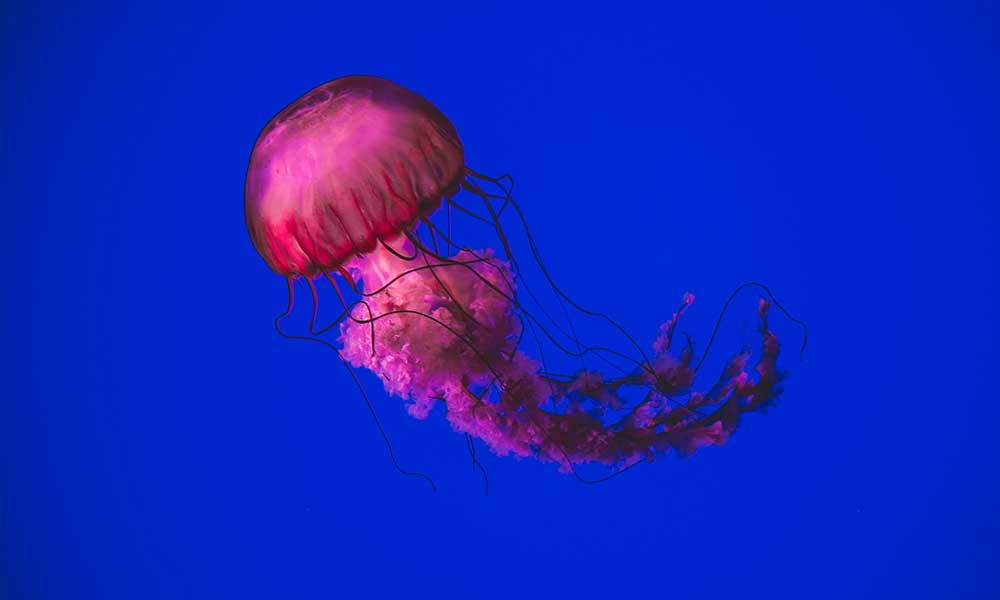Before you ask your friend to pee on your jellyfish sting, we suggest you read this guide about the best way to treat a jellyfish sting. You can thank us later.
Unfortunately, urine is not proven to work well for treating jellyfish stings, although it’s a popular myth.
Let’s get more into why peeing on a jellyfish sting doesn’t work.
Should You Pee On A Jellyfish Sting?
Many different studies performed haven’t found it to be an effective way of reducing the pain making the sting heal faster. Time, instead of urine, will heal the affected area.
If you attempt to pee on the sting, it can trigger more pain as it prompts the cells to release even more venom.
Instead, use apple vinegar or rubbing alcohol on the site to release more of the toxin.
You can also pour hot water over the injury in a shower or bath for an average of 20 minutes.
The temperature of the water should range from 104 to 113 degrees.
What Does A Jellyfish Sting Look Like?
If you get stung by a jellyfish, you can expect it to look like an intense rash with small or large red bumps present across large areas of the skin.
Inflammation may also be present on the area.
This type of sting looks similar to hives and can look like thin lines on different areas of the body.
You can expect for it to look like you were hit with a whip.
As the lines heal, they can cause bruising to occur, depending on where you were stung.
The sting will look like small cuts across the area of the body that was stung and can develop into scabs as it starts to heal. Every person reacts differently to jellyfish stings.
Those who have poor immune systems may experience more severe side effects and can take longer to heal.
Although itching the affected site may seem natural, this can cause the pain to become worse as it causes more venom to be released.
Do All Jellyfish Sting?
Yes, all types of jellyfish sting, making it necessary to use caution any time you’re in the water and not to assume that some types of jellyfish are safe to have proximity with while swimming in the ocean.
Although all jellyfish sting, some of them have a mild sting that is less intense than others.
The Pleurobrachia Bachei, also known as sea gooseberries, and Aurelia Aurita, or moon jelly, don’t have as strong of a sting.
Fortunately, only a portion of the jellyfish in the water accidentally have contact with swimmers and the stings are typically not serious or require medical treatment.
What Should You Do If You Get Stung By A Jellyfish?
If you get stung by a jellyfish, you’ll need to rinse the affected area with seawater to remove any tentacles that may be stuck in the skin.
The tentacles should be removed as quickly as possible because they can continue to release venom.
Avoid using freshwater, which causes more pain as it prompts extra venom to be released.
Use a dry towel to remove any tentacles.
Coating the tentacles with shaving cream can make them easier to remove.
Wear gloves during this process to avoid getting the tentacles stuck in your fingers.
You can also use a credit card or razor to gently lift them out of the skin without causing further damage.
It’s also necessary to protect the affected area and avoid having further contact with sand to prevent infections.
Steroid creams, antihistamines, and pain relievers will help alleviate some of the pain and discomfort while promoting healing.
Some lifeguards use anti-venom medication and morphine to treat swimmers that have suffered from more severe stings.
Why Does Vinegar Help Jellyfish Stings?
Vinegar is extremely effective to use because it removes the nematocysts, a cell in the tentacle of a jellyfish containing a barb or venomous coil, to prevent them from firing, which prevents as more venom from being released into your skin.
After you apply the vinegar, you still need to manually move all of the stingers from the skin.
Vinegar rapidly reduces pain, especially if you follow the vinegar with shaving cream, hydrocortisone cream, or calamine lotion. For the inflammation, apply ice packs or hot water.
How Long Does A Jellyfish Sting Last?
After you suffer a jellyfish sting, the pain is immediate and the most intense in the first few hours.
It can itch, throb, and burn constantly, making it difficult to perform other types of activities.
The welts can take one to two weeks to fully heal. Skin rashes that become itchy commonly develop one to four weeks after the sting occurs.
Fortunately, jellyfish stings are typically not life-threatening and the pain subsides after 24 hours.
Without any medical treatment, the pain can be uncomfortable for some people, especially children.
The Most Painful or Fatal Jellyfish Stings
The box jellyfish is also known to be extremely dangerous and is one of the most venomous animals in the ocean.
A few types of jellyfish belong to the jellyfish box family, which includes 50 different species.
Irukandji jellyfish are known to be the most painful and fatal jellyfish stings and can lead to brain hemorrhages.
This jellyfish is a species of box jellyfish and measures .2 inches in length.
This causes 50 to 100 people to seek medical treatment every year due to this type of injury.
The Sea Wasp jellyfish can also be deadly and can kill up to 60 people with just one of its darts.
Each jellyfish contains up to half a million darts, which are all microscopic but can lead to significant pain if you brush up against them.
It’s important to seek medical attention if you begin to experience side effects like difficulty breathing, skin blistering, nausea or vomiting, difficulty, worsening redness, muscle cramps, and chest pain.







